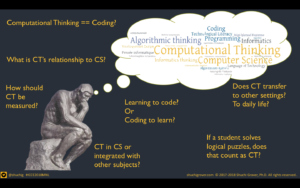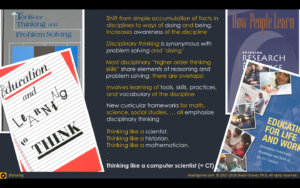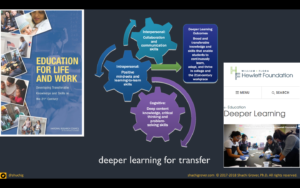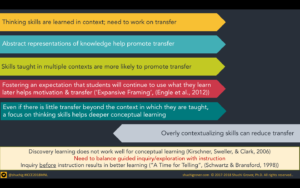 In it I addressed several questions that have been raised about CT, and shared my evolving understandings of computational thinking — as a disciplinary thinking skill for CS (“thinking like computer scientists”) for deeper learning of CS (as Knuth and Denning articulated) and the Papertian/diSessian (“CT integration”) view of CT as programming to aid sense-making in other subjects. I shared concrete examples on the former from my work on the FACT curriculum at Stanford and the VELA project – both of which address deeper conceptual learning of programming. On the latter “CT integration view”, I shared examples from the C2STEM project involving computational modeling in high school Physics and the recent work on ideas for CT to enrich literature.
In it I addressed several questions that have been raised about CT, and shared my evolving understandings of computational thinking — as a disciplinary thinking skill for CS (“thinking like computer scientists”) for deeper learning of CS (as Knuth and Denning articulated) and the Papertian/diSessian (“CT integration”) view of CT as programming to aid sense-making in other subjects. I shared concrete examples on the former from my work on the FACT curriculum at Stanford and the VELA project – both of which address deeper conceptual learning of programming. On the latter “CT integration view”, I shared examples from the C2STEM project involving computational modeling in high school Physics and the recent work on ideas for CT to enrich literature.



As enlightening as those examples were (as I was told by more than one researcher in the audience), I believe what was also valuable for educators to takeaway were concrete insights from the learning sciences on disciplinary thinking skills and how to teach for transfer — pedagogical ideas particularly useful for teaching CT & programming in #CSForAll.
Breadth and depth of computational thinking in a bullet train keynote by @shuchig #ICCE2018MNL Connections with 21cc, curriculum, programming, authentic learning, deeper learning, motivation… learnt a lot! Thanks! pic.twitter.com/bYDkMIHSS6
— Elizabeth Koh (@elizabethkoh) November 29, 2018
Excellent talk by Shuchi Grover on CT. Clarifying to think of CT for CS and CT for integration @ICCE2018MNL @shuchig pic.twitter.com/FhbRpsZx9G
— ck looi (@ck_cklooi2010) November 29, 2018
There appears to be lingering confusion about CT primarily, as I see it, from computational scientists who see CT as nothing more than computational science. Clearly their perspective is limited to the use of computational modeling in science classrooms. That limited view does not acknowledge the value of a focus on disciplinary thinking and problem solving for CS classrooms (like mathematical thinking in math and thinking like a historian in history classrooms), or the immense value of CT not just for science but for several other subjects – like math, and social studies, and language arts. Take a look at my latest article on Edsurge, for example, on Helping Students See Hamlet and Harry Potter in a New Light With Computational Thinking — an article that received some amazing responses on Twitterverse!



